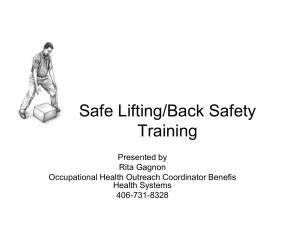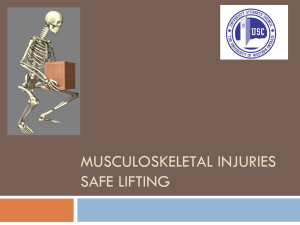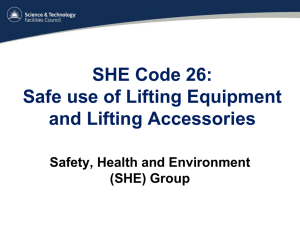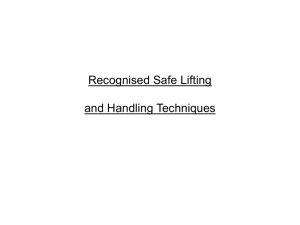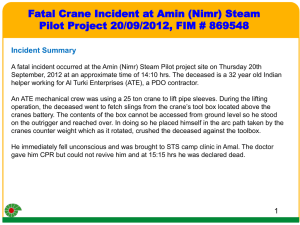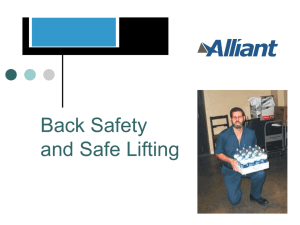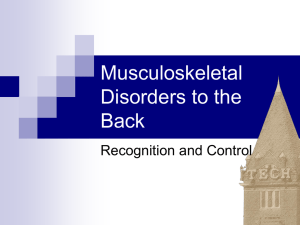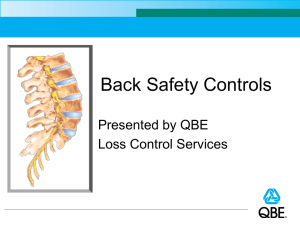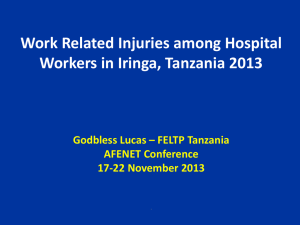Safe Lifting Training
advertisement
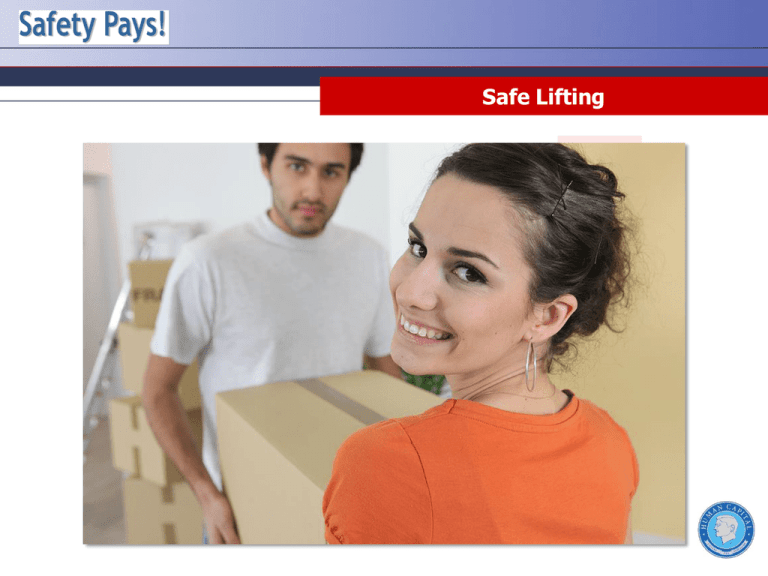
Safe Lifting Disclaimer • This training material presents very important information. • Your organization must do an evaluation of all exposures, applicable codes and regulations, and establish proper controls, training, and protective measures to effectively control exposures and assure compliance. • This program is neither a determination that the conditions and practices of your organization are safe nor a warranty that reliance upon this program will prevent accidents and losses or satisfy local, state or federal regulations. • All procedures and training, whether required by law or not, should be implemented and reviewed by safety and risk management professionals, and legal counsel to ensure that all local, state and federal requirements are satisfied. Course Outline – Safe Lifting 1. 2. 3. 4. 5. 6. 7. 8. Why Take Safe Lifting Training? Back Anatomy Causes of Injury and Discomfort Your Personal Preparation Scenarios: Proper Techniques Specialized Lifting Techniques What Else Will Help? Summary Why Take Safe Lifting Training? Back injuries are the number one workplace safety issue: • Back injuries account for 20% of all injuries and illnesses in the workplace. Only colds and flu account for more time off. • Cumulative trauma injuries which include back injuries account for 31% of all workplace injuries and 43% of the cost of claims. • These injuries result in costs and aggravation for the injured person. • They also create problems for the organization with lost time, productivity impacts and higher insurance costs. Why Take Safe Lifting Training? Back injuries are the number one workplace safety issue (continued): • Preventive training and awareness is in everyone’s best interests! • The General Duty Clause of the federal workplace safety statute requires employers to provide employees with a workplace that is “free of recognized hazards.” • Employers should have an ergonomics program and back safety is the foundation of an effective ergonomics program. Back Anatomy How your back works: • The S-curve in your back acts as a giant spring to support weight. • Discs provide cushion between vertebra. • Nerves branch out from spinal cord. Disc Vertebrae Back Anatomy How your back works (continued): • Ligaments hold the skeletal structure together. • There are relatively few muscles in the back. Support comes from the stomach and spine. Back Anatomy How your back works (continued): • Neutral posture is the proper alignment of the body between extremes. The ears, shoulders, hips, knees and ankles are aligned. • This is the strongest and most balanced position when stress is most minimal. Causes of Injury and Discomfort The most common types: • Strains from overused or overstretched muscles. • Sprains from torn ligaments as a result of sudden movement. • Herniated disk from the loss of the spine’s cushioning ability. This is usually caused from strain and aging. Causes of Injury and Discomfort Contributing factors: • Repetitive work, i.e., bending, twisting, pushing, pulling and lifting. • Slipping, tripping and falling. • Twisting while spine is supporting a heavy load. • Heavy physical work. Causes of Injury and Discomfort Contributing factors (continued): • Poor physical condition. • Being overweight. • Loss of flexibility. • Body mechanics and work habits. • Stressful living. Your Personal Preparation Your health: • Maintain good physical health. • Be properly rested. • Eat right. • Reduce stress in your life. Your Personal Preparation Stretching and strengthening: • Stretching before exposure, both preshift and pre-task, will reduce the likelihood of an injury. • Routine strengthening exercises and a physical fitness routine will also reduce the likelihood of an injury. Your Personal Preparation Shoes and back support: Shoes: • Wear proper shoes for the job. They must include non-slip soles. Back support recommendations: • • Optional use of a lifting belt for additional back support may help if you are experiencing any back issues. The lifting belt helps by reminding you to use proper body positioning and to not lift more weight. Note: NIOSH studies indicate that back supports do not statistically reduce risk of injury. Scenarios: Proper Techniques Awareness and prevention: • Attack the bottom level of the accident triangle. • Reduce overextension, twisting, overloading, and non-neutral posture at work. 1 Disability 10 Lost Time 100 Medical 1000 Sore Backs MOST IMPACT 10,000 times of overextension, twisting, poor posture, overloading Scenarios: Proper Techniques Over-extension: • Over-extension is reaching out and away from the body which greatly increases injury risk. • The further a weight is from the body, the more force necessary to do the work. • Moving closer to the load or moving the load closer to the lifter prior to lifting is one control. Scenarios: Proper Techniques Over-extension (continued): • For standing workstations you must have the work area in the proper range. Neck and arms are out of position. Good neutral position. Scenarios: Proper Techniques Over-extension (continued): •Set up the work area to keep weights close to you and at waist level. Scenarios: Proper Techniques Twisting: • When we twist, our knee, hips and shoulders are not in line. • Twisting wears on the vertebra, disc joints, and "unsprings" the back. • To avoid twisting, a simple control is to move your feet and/or to re-configure your workstation. Scenarios: Proper Techniques Overloading: • Lifting more cumulative weight than our body can handle. • Overloading is individuallybased. Ten pounds is too much for some; others can lift 50. Scenarios: Proper Techniques Overloading (continued): • Over-extension affects overloading. The further the weight is from your body, the greater the force on your spine. • Weight should be maintained close to waist level centered between the knees and shoulders. • As a general rule, other methods of handling such as two-person lifts or manual material handling aids should be used for weights over 50 lbs. Scenarios: Proper Techniques Bending and lifting: • Lifting doesn’t have to be dangerous. If you use proper techniques you can protect yourself from injury. • The spine acts as a large spring to help reduce the muscle load. When we “unspring" our spines, we correctly force our muscles to do all the work. Advice: Too much pressure on the back and not enough use of the legs. Scenarios: Proper Techniques Bending and lifting (continued): • • • • • • • • • • • Ensure that the load is a safe weight. Ensure it is safe and not hazardous. Keep the feet apart and staggered. Squat to lift and lower. Minimize bending at the waist. Keep the back bowed in while bending. Get a good grip. Keep the weight close to the body. Keep load centered near the waist. Turn with the feet and not the body. Do not twist or jerk suddenly. Scenarios: Proper Techniques Neutral (anatomical) posture: • Remain vertical and balanced. • The farther out-of-neutral a worker is, the greater the likelihood of injury. • For the spine, never be more than one step out-of-neutral. • Being out-of-neutral affects other joints in addition to the back: wrists, shoulders, elbows, and neck. Specialized Lifting Techniques Heavy weight items: • Stretch at the beginning of the shift and prior to undertaking tasks. • Clear the set point and path of travel! Specialized Lifting Techniques Higher weight items: • Is it a safe lift? Consider other options like using a two-person lift or lifting equipment. • Use legs, not back. • Get close and cradle the load at the center of the body. • Have good grip surface. • Keep load close to body during handling. Advice: This lift should be centered closer to the waist, using the legs to lift. Specialized Lifting Techniques Higher weight items (continued): • Use lift assist equipment. • Keep load stable. • Do not over-stack; make two trips, if necessary. Advice: This load is unstable and unsafe. What Else Will Help? Check your surroundings: • Is a clear path established? Remember the shortest way isn’t always the smartest way. • Is the ground and pathway stable, level and not slick? • Is lighting sufficient? • Is area adjacent and above clear of obstructions? • Is a clear set point established? What Else Will Help? Use mechanical help: • Use dolly, conveyor, hand-truck, or forklift options as needed. • When using mechanical help, remember that pushing, and not pulling, allows more control and greater leverage. • Secure the load to equipment so sudden stops don’t displace the load. What Else Will Help? Teamwork: • Identify when and where two-person lifts are required. • When you can’t handle it by yourself get help! What Else Will Help? Teamwork (continued): •What poor practices or hazards do you see in your company? •What can be improved upon? •What operational controls could be used to help, i.e., scissor lifts, packaging machines etc. •Report issues to your safety committee and management. Summary • Back injuries: Are the number one workplace safety issue, resulting in costs to personnel and the organization. • Strains, sprains and herniated disks: Are common injuries that can be prevented with proper techniques when positioning, moving, lifting, and carrying. • Personal preparation: Requires maintaining good physical health, stretching exercises and using proper shoes and equipment. • Proper techniques: Use to reduce overloading, overextension, twisting, unsafe lifting and poor posture. Summary • Specialized lifting techniques: These are required for heavy and higher weight items. • Check your surroundings: In advance to ensure the work area is hazard free and safe. • Mechanical help: Forklifts, hand-trucks, etc. will make the job easier and safer. • Rely on teamwork: To assist on heavy lifts and to identify areas of improvement and additional equipment that will enhance operations. Safe Lifting This form documents that the training specified above was presented to the listed participants. By signing below, each participant acknowledges receiving this training. Organization: Trainer: Trainer’s Signature: Class Participants: Name: Signature: Date: Name: Signature: Date: Name: Signature: Date: Name: Signature: Date: Name: Signature: Date: Name: Signature: Date: Name: Signature: Date: Name: Signature: Date: Name: Signature: Date: Name: Signature: Date: Name: Signature: Date: Name: Signature: Date: Name: Signature: Date: Remember to load your completed trainings into the Training Track application of the Risk Management Center.
